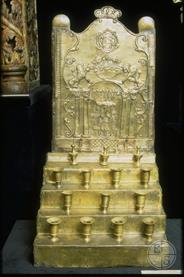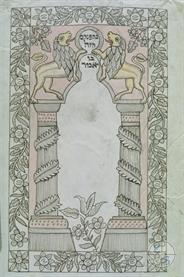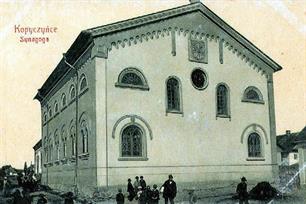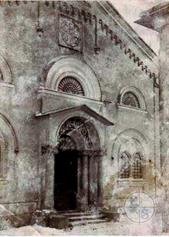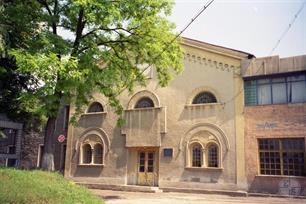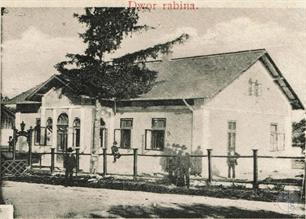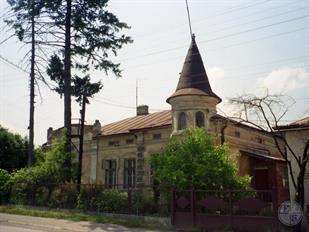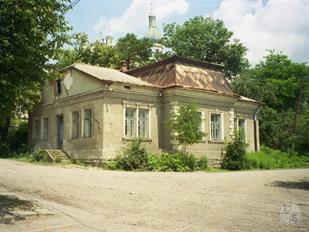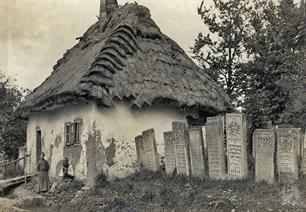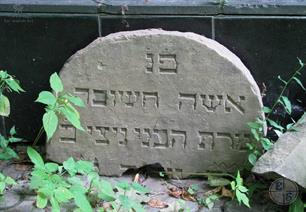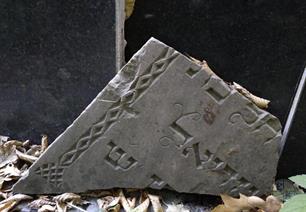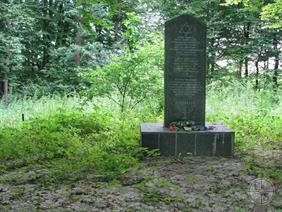Kopychyntsi
Chortkiv district, Ternopil region
Sources:
- Pinkas Hakehillot Polin: Encyclopedia of Jewish Communities, Poland, Volume II, pages 486-489, published by Yad Vashem, Jerusalem. Translated by Lancy Spalter, JewishGen, Inc.
Photo:
- Zev Radovan, Benjamin Lukin, Vladimir Levin - Center for Jewish Art, Kopychyntsi, Ukraine
- Храми України. Копичинці, синагога
- Мандрівка Старим Кордоном. Копичинці
- Iryna Nebesna, Копичинці
- Instytut Sztuki PAN. Kopyczynce, scena uliczna
- Collection of Alex Friedman. Jewish Ukraine
- Pinkas Hakehillot Polin: Encyclopedia of Jewish Communities, Poland, Volume II, pages 486-489, published by Yad Vashem, Jerusalem. Translated by Lancy Spalter, JewishGen, Inc.
Photo:
- Zev Radovan, Benjamin Lukin, Vladimir Levin - Center for Jewish Art, Kopychyntsi, Ukraine
- Храми України. Копичинці, синагога
- Мандрівка Старим Кордоном. Копичинці
- Iryna Nebesna, Копичинці
- Instytut Sztuki PAN. Kopyczynce, scena uliczna
- Collection of Alex Friedman. Jewish Ukraine
Year - Total Population - Jews
1765 - (?) - 346
1880 - 6,221 - 2,253
1890 - 6,967 - 2,467
1900 - 7,190 - 2,197
1910 - 7,171 - 2,109
1921 - 7,923 - 2,471
1931 - (?) - 2,590
1765 - (?) - 346
1880 - 6,221 - 2,253
1890 - 6,967 - 2,467
1900 - 7,190 - 2,197
1910 - 7,171 - 2,109
1921 - 7,923 - 2,471
1931 - (?) - 2,590
The Jewish Community from its beginnings to WWII
Kopyczynce (ukr. Kopychyntsi, Копичинці) was known as a village in the first half of the 15th Century (in 1443, a church was built). In 1615 the noble family of Kopyczynsky took possession of the village. A fortress was built in Kopyczynce, which more than once had to stand the sieges of Tatars and Turks. Frequent invasions caused much damage to the community. Kopyczynce became known as a noble-owned urban settlement during the late 17th or early 18th Century. During that time, and especially during the 19th Century, Kopyczynce developed into a trade, craft and agricultural industry center for the fertile agricultural surroundings, and mostly for the large noble estates. In the late 19th and 20th Centuries, the area produced fine wheat, sugar beet, flax and oleaceous plants – raw materials for the small local industries. And, indeed, Kopyczynce saw the establishment of an oil plant, two breweries, a sawmill and a brick factory. The town grew rapidly after it was connected to the railway that led to Ternopol. Kopyczynce was not particularly damaged during WWI; therefore, the sub-district government was moved from Husyatin to Kopyczynce during the inter-war period.
The first Jews apparently settled in Kopyczynce at the end of the 17th Century. It is known that in 1716 the small Jewish settlement of Kopyczynce was annexed to the Ternopol community. During the second half of the same century, the Jewish community of Kopyczynce was independent and ruled over the Jews scattered in its surroundings. Side by side with the Jewish denizens of Kopyczynce itself (total of 48) there were 438 taxpayers listed under the control of the Kopyczynce community. Jacob Frank, founder of the Frankist sect, resided in Kopyczynce in 1755 and probably a number of his Chassidim were part of the Jewish population of Kopyczynce. Chaim Ben-Moshe from Kopyczynce appears in the list of controversial Frank Chassidim in Kamenets Podolsk in 1557.
The Jewish community of Kopyczynce grew rapidly during the second half of the 19th Century. Its reduced number in the years 1900-1910 is connected with the increased emigration to overseas lands. With the end of WWI the size of the population increased once again on account of nearby communities (such as Husyatin), which were badly damaged during the Russian conquest. During the dominion of the West Ukrainian Republic in Kopyczynce (November 1918 – May 1919), the Jews formed a militia which was dissolved by the authorities, claiming that the Jews had not abided by their declared neutrality in the Polish-Ukrainian conflict. In 1920, after the retreat of the Bolsheviks, units of the Peltura army raided Kopyczynce and tormented the Jews; 3-5 Jews were murdered, 14 were wounded, and women were raped.
Kopyczynce (ukr. Kopychyntsi, Копичинці) was known as a village in the first half of the 15th Century (in 1443, a church was built). In 1615 the noble family of Kopyczynsky took possession of the village. A fortress was built in Kopyczynce, which more than once had to stand the sieges of Tatars and Turks. Frequent invasions caused much damage to the community. Kopyczynce became known as a noble-owned urban settlement during the late 17th or early 18th Century. During that time, and especially during the 19th Century, Kopyczynce developed into a trade, craft and agricultural industry center for the fertile agricultural surroundings, and mostly for the large noble estates. In the late 19th and 20th Centuries, the area produced fine wheat, sugar beet, flax and oleaceous plants – raw materials for the small local industries. And, indeed, Kopyczynce saw the establishment of an oil plant, two breweries, a sawmill and a brick factory. The town grew rapidly after it was connected to the railway that led to Ternopol. Kopyczynce was not particularly damaged during WWI; therefore, the sub-district government was moved from Husyatin to Kopyczynce during the inter-war period.
The first Jews apparently settled in Kopyczynce at the end of the 17th Century. It is known that in 1716 the small Jewish settlement of Kopyczynce was annexed to the Ternopol community. During the second half of the same century, the Jewish community of Kopyczynce was independent and ruled over the Jews scattered in its surroundings. Side by side with the Jewish denizens of Kopyczynce itself (total of 48) there were 438 taxpayers listed under the control of the Kopyczynce community. Jacob Frank, founder of the Frankist sect, resided in Kopyczynce in 1755 and probably a number of his Chassidim were part of the Jewish population of Kopyczynce. Chaim Ben-Moshe from Kopyczynce appears in the list of controversial Frank Chassidim in Kamenets Podolsk in 1557.
The Jewish community of Kopyczynce grew rapidly during the second half of the 19th Century. Its reduced number in the years 1900-1910 is connected with the increased emigration to overseas lands. With the end of WWI the size of the population increased once again on account of nearby communities (such as Husyatin), which were badly damaged during the Russian conquest. During the dominion of the West Ukrainian Republic in Kopyczynce (November 1918 – May 1919), the Jews formed a militia which was dissolved by the authorities, claiming that the Jews had not abided by their declared neutrality in the Polish-Ukrainian conflict. In 1920, after the retreat of the Bolsheviks, units of the Peltura army raided Kopyczynce and tormented the Jews; 3-5 Jews were murdered, 14 were wounded, and women were raped.
In the early 19th Century, when the Jewish community of Kopyczynce had reached stability, a synagogue and a religious learning institution were established. By the end of the century 5 additional prayer houses had been founded (of the Chortkov and Husyatin Chassidim). For as long as the community existed, it maintained all Jewish institutions (Chevra Kadisha burial society, attention to the sick, charity, etc.). At the end of WWI the Jewish community, under the auspices of the Joint and in association with the Town Hall, built a public kitchen which catered 150 free meals a day to the needy. In 1937, the Town Hall cut the budget and the kitchen closed down. In the 1930's the community budget was quite limited – some 20,000 zloty per year – barely enough for the committee to finance the basic needs.
In 1920, the bathhouse and ritual purification bath were reformed with funds from the Joint. In the 1920's the 11 orphans of Kopyczynce were housed with local families and sustained by the community of Ternopol. During the late 19th and early 20th Century, the majority of the community's committee was Orthodox and the minority were assimilated, specifically representatives the professional Intelligentsia. In the inter-war period, the majority of the committee was in the hands of Zionist representatives. Until WWI, the Jews held one-third of the seats of the Town Hall Council. In the 1920's the authorities appointed a Kommissar on their behalf, and in the 1933 elections only 3 Jews (Zionist) were elected from a total of 16 seats.
Known local Rabbis: Rabbi Chaim Yaakov Rappaport during mid 19th Century; from the early 20th Century – Rabbi Abraham bar Chaim Rosenberg, who devotedly officiated also during the inter-war period.
As mentioned, since 1894 Rabbi Yitzhak Meir bar Abraham Heshel, head of the Chassidic court, sat in Kopyczynce. He was fourth generation to Rabbi Abraham Yehoshua Heschel from Opatow, and son-in-law to the Husyatin Chassidic Rabbi Mordechai-Shraga Friedman. Most of his Chassidim were plain people. Apparently, Rabbi Yitzhak Meir served also as Rabbinical Judge of the place. In 1914 he fled to Vienna (died 1935). His son, Rabbi Abrahm Yehoshua Heschel, succeeded him shortly after WWI. In 1936 he emigrated to Vienna and from there to the U.S.A. (he died in 1967).
The Orthodox Associations “Agudat Hacharedim” and “Agudat Tifferet Hadat” were created in Kopyczynce in 1912 on the initiative of Rabbi Yitzhak Meir and Rabbi Abraham Rosenberg.
In 1920, the bathhouse and ritual purification bath were reformed with funds from the Joint. In the 1920's the 11 orphans of Kopyczynce were housed with local families and sustained by the community of Ternopol. During the late 19th and early 20th Century, the majority of the community's committee was Orthodox and the minority were assimilated, specifically representatives the professional Intelligentsia. In the inter-war period, the majority of the committee was in the hands of Zionist representatives. Until WWI, the Jews held one-third of the seats of the Town Hall Council. In the 1920's the authorities appointed a Kommissar on their behalf, and in the 1933 elections only 3 Jews (Zionist) were elected from a total of 16 seats.
Known local Rabbis: Rabbi Chaim Yaakov Rappaport during mid 19th Century; from the early 20th Century – Rabbi Abraham bar Chaim Rosenberg, who devotedly officiated also during the inter-war period.
As mentioned, since 1894 Rabbi Yitzhak Meir bar Abraham Heshel, head of the Chassidic court, sat in Kopyczynce. He was fourth generation to Rabbi Abraham Yehoshua Heschel from Opatow, and son-in-law to the Husyatin Chassidic Rabbi Mordechai-Shraga Friedman. Most of his Chassidim were plain people. Apparently, Rabbi Yitzhak Meir served also as Rabbinical Judge of the place. In 1914 he fled to Vienna (died 1935). His son, Rabbi Abrahm Yehoshua Heschel, succeeded him shortly after WWI. In 1936 he emigrated to Vienna and from there to the U.S.A. (he died in 1967).
The Orthodox Associations “Agudat Hacharedim” and “Agudat Tifferet Hadat” were created in Kopyczynce in 1912 on the initiative of Rabbi Yitzhak Meir and Rabbi Abraham Rosenberg.
The Second World War
During the Soviet rule (1939-1941) the situation of the Kopyczynce Jews was similar to other places in the region. The community activities were discontinued and the economy was paralyzed.
The Germans conquered the city on 7/7/41. On the first day of the conquest the German soldiers killed several Jews. The following day the Ukrainian militia evicted 50 Jews to forced labor with torture and humiliation. A few days later, 8 Jews were sentenced to death on charges of collaboration with the Soviets. On July 12 the Jews were commanded to wear a white band with a blue Star of David on their right sleeves. In the same month the Judenrat, headed by J.J. Zellermeyer, was established. Before long, the structure of the Judenrat was changed and Hermann Roller was appointed to head it. A Jewish police worked side by side with the Judenrat. Its first commander was David Locker, who was followed by J. Temerling, a felon. Maurice Roller, the brother of the head of the Judenrat, succeeded him.
In August 1941, a contribution was imposed on the Kopyczynce community: 1 kg of gold and tens of thousands of rubles. 12 Jews were arrested as hostages to ensure the fulfillment of the ruling. In early August hundreds of Jewish refugees from Carpatho-Ruthenia were carried along the streets of Kopyczynce. The local community assisted them and did their best to alleviate their suffering. At the end of August the Germans set fire synagogues in town together with their Torah scrolls.
Further decrees were dictated to the Jewish community in September 1941. The doors to their houses had to be marked with a Star of David. They could not leave town without a pass. They were allowed to buy in the town market only between 11:00-14:00, after the gentiles had finished their shopping and there was little left to buy.
On November 8, 1941, some 200 Jews were taken to the labor camp in Kamionka. In December 1941 more Jews were seized for labor camp, this time to Borki-Wielkie. On March 20, 1942, about 150 Jews were taken out of Kopyczynce to clean the roads leading to the city from snow. However, without prior notice, they were taken by the Gestapo to Chortkov, where they were held in jail for three days. From there, 100 were led to the camp in Kamionka and 50 to the labor camp in Gleboczek-Wielki.
To assist the needy, a branch of the J.S.S. worked in Kopyczynce side by side with the Social Aid Department of the Judenrat. The Jewish activists of both organizations created public kitchens, sent packages of food to the labor camps and gave out money to the poor of the community.
On the Judenrat's initiative, sewing workshops were established in Kopyczynce to sew linen and to embroider cloths, which brought in a small income but, especially, passes that granted a certain immunity from being snatched away to labor camps. A clinic was also created to take care of typhus-stricken patients.
In May 1942, some 50 Jewish women from Kopyczynce were taken to the women's labor camp of Jagelnica. They worked in agricultural farms in the area. In these farms, the Soviets had started to raise plants from which to extract rubber, and the Germans continued the experiments. In June a group of Jews were taken to the labor camp Stopki. In August 1942, 200 elderly and sick from Chortkov were brought in to Kopyczynce.
On September 30, 1942, a massive action started. The Germans with Ukrainian help, broke into the Jewish homes, took out the residents and carried them to the market square, next to the Judenrat's offices. In the course of this action, walls, floors and warehouses were torn down to discover hidden people. Some 50 sickly Jews were slain at home or on the streets. On the evening of the same day, the hostages were carried from the marketplace to the train station where 70 men were sent off to the Janowska camp in Lvov and the rest – 1,000 people – were sent to Belzec for extermination. The Kopyczynce Judenrat was demanded to pay for the sustenance of the Germans and the Ukrainian police, the action perpetrators.
In October 1942 groups of Jews from Chorostkov, Provozhna and the remainder of the Husyatin community were transferred to Kopyczynce and concentrated in a ghetto together with the local Jews.
Disease in the ghetto increased during the winter of 1942-1943 as a result of congestion, poor sanitary conditions and hunger.
At the beginning of 1943, the Jews of Kopyczynce were further victimized. Those caught beyond the boundaries of the ghetto without a proper permit were transfered to the jail in Chortkov and only a few came back alive. The ghetto residents were caught in a frenzy to build hiding places to protect themselves during coming actions.
And indeed, on April 15, 1943, a new action burst out. Most of the ghetto residents hid. The Germans strived to find the hideaways. Those discovered were taken to the nearby forest and shot into previously dug pits. A few resisted but the massacre totalled 400 Jews.
In the spring of 1943 there were rumors in the Kopyczynce ghetto about the activities of Soviet partisans and attempts were made at making contact. With this purpose, Dr. Fest left for the forest but never returned. Another physician, Dr. Chaim Ox-Tahler, succeeded in joining the partisans and several young men followed him.
During the Soviet rule (1939-1941) the situation of the Kopyczynce Jews was similar to other places in the region. The community activities were discontinued and the economy was paralyzed.
The Germans conquered the city on 7/7/41. On the first day of the conquest the German soldiers killed several Jews. The following day the Ukrainian militia evicted 50 Jews to forced labor with torture and humiliation. A few days later, 8 Jews were sentenced to death on charges of collaboration with the Soviets. On July 12 the Jews were commanded to wear a white band with a blue Star of David on their right sleeves. In the same month the Judenrat, headed by J.J. Zellermeyer, was established. Before long, the structure of the Judenrat was changed and Hermann Roller was appointed to head it. A Jewish police worked side by side with the Judenrat. Its first commander was David Locker, who was followed by J. Temerling, a felon. Maurice Roller, the brother of the head of the Judenrat, succeeded him.
In August 1941, a contribution was imposed on the Kopyczynce community: 1 kg of gold and tens of thousands of rubles. 12 Jews were arrested as hostages to ensure the fulfillment of the ruling. In early August hundreds of Jewish refugees from Carpatho-Ruthenia were carried along the streets of Kopyczynce. The local community assisted them and did their best to alleviate their suffering. At the end of August the Germans set fire synagogues in town together with their Torah scrolls.
Further decrees were dictated to the Jewish community in September 1941. The doors to their houses had to be marked with a Star of David. They could not leave town without a pass. They were allowed to buy in the town market only between 11:00-14:00, after the gentiles had finished their shopping and there was little left to buy.
On November 8, 1941, some 200 Jews were taken to the labor camp in Kamionka. In December 1941 more Jews were seized for labor camp, this time to Borki-Wielkie. On March 20, 1942, about 150 Jews were taken out of Kopyczynce to clean the roads leading to the city from snow. However, without prior notice, they were taken by the Gestapo to Chortkov, where they were held in jail for three days. From there, 100 were led to the camp in Kamionka and 50 to the labor camp in Gleboczek-Wielki.
To assist the needy, a branch of the J.S.S. worked in Kopyczynce side by side with the Social Aid Department of the Judenrat. The Jewish activists of both organizations created public kitchens, sent packages of food to the labor camps and gave out money to the poor of the community.
On the Judenrat's initiative, sewing workshops were established in Kopyczynce to sew linen and to embroider cloths, which brought in a small income but, especially, passes that granted a certain immunity from being snatched away to labor camps. A clinic was also created to take care of typhus-stricken patients.
In May 1942, some 50 Jewish women from Kopyczynce were taken to the women's labor camp of Jagelnica. They worked in agricultural farms in the area. In these farms, the Soviets had started to raise plants from which to extract rubber, and the Germans continued the experiments. In June a group of Jews were taken to the labor camp Stopki. In August 1942, 200 elderly and sick from Chortkov were brought in to Kopyczynce.
On September 30, 1942, a massive action started. The Germans with Ukrainian help, broke into the Jewish homes, took out the residents and carried them to the market square, next to the Judenrat's offices. In the course of this action, walls, floors and warehouses were torn down to discover hidden people. Some 50 sickly Jews were slain at home or on the streets. On the evening of the same day, the hostages were carried from the marketplace to the train station where 70 men were sent off to the Janowska camp in Lvov and the rest – 1,000 people – were sent to Belzec for extermination. The Kopyczynce Judenrat was demanded to pay for the sustenance of the Germans and the Ukrainian police, the action perpetrators.
In October 1942 groups of Jews from Chorostkov, Provozhna and the remainder of the Husyatin community were transferred to Kopyczynce and concentrated in a ghetto together with the local Jews.
Disease in the ghetto increased during the winter of 1942-1943 as a result of congestion, poor sanitary conditions and hunger.
At the beginning of 1943, the Jews of Kopyczynce were further victimized. Those caught beyond the boundaries of the ghetto without a proper permit were transfered to the jail in Chortkov and only a few came back alive. The ghetto residents were caught in a frenzy to build hiding places to protect themselves during coming actions.
And indeed, on April 15, 1943, a new action burst out. Most of the ghetto residents hid. The Germans strived to find the hideaways. Those discovered were taken to the nearby forest and shot into previously dug pits. A few resisted but the massacre totalled 400 Jews.
In the spring of 1943 there were rumors in the Kopyczynce ghetto about the activities of Soviet partisans and attempts were made at making contact. With this purpose, Dr. Fest left for the forest but never returned. Another physician, Dr. Chaim Ox-Tahler, succeeded in joining the partisans and several young men followed him.
The influence of the Chassidic Rabbi and his followers delayed the establishment of an organized Zionist movement in Kopyczynce. Such was created only in 1908 and its founders were members of the professional Intelligentsia.A clubhouse was erected and it contained a library and a lecture hall. In 1909, the Zionists founded a complementary Hebrew school following the “Saffah Berurah” (Clear Language) and by 1910 it employed two teachers.
The momentum of the Zionist movement in Kopyczynce took place in the inter-war period. By 1919 there was already a chapter of Hashomer Hatzair in town. In the early 1920's, Kopyczynce-born Pinchas Lubianiker (Pinchas Lavon) was active; he later founded the Gordonia movement, became one of the leaders of the Labor movement in Eretz Israel, was Secretary Genereal of the Histadruth (the Workers Federation) and served as Minister in the Government of Israel. On his initiative, a Gordonia chapter was constituted in Kopyczynce as well as an Aid Committee, which he headed in 1922. The Gordonia chapter continued its activities until 1939, and it housed a library and a drama group. Hechalutz organized a chapter in Kopyczynce in 1920. In later years, branches of other Zionist organizations were established: Hanoar Hatzioni (1930), Betar (1931), Achva (1933) and Hashachar (1938). The General Zionists concentrated in Kopyczynce in the Hatechiah organization. A branch of Hitachdut was founded in 1923 and a branch of the Revisionists in 1930. The result of the elections to the Zionist Congress in 1931 by votes was: General Zionists – 55, Mizrachi – 3, Hitachdut – 120, Revisionists – 180, Radicals – 1. In the 1935 elections: General Zionists – 425, Labor Eretz-Israel – 431, Medina Party – 66, Hashachar – 2 votes.
Between the two World Wars the complementary Hebrew school continued its activity, together with the public committee of “Tarbut”. In 1931 a kindergarten was created. The Jewish Sports Association “Trumpeldor” operated in town in the 1930's; its main branch was soccer. An additional sports club was established in Kopyczynce in 1938 – Z.K.S. (Jewish Sports Club) – that offered soccer and athletics.
The momentum of the Zionist movement in Kopyczynce took place in the inter-war period. By 1919 there was already a chapter of Hashomer Hatzair in town. In the early 1920's, Kopyczynce-born Pinchas Lubianiker (Pinchas Lavon) was active; he later founded the Gordonia movement, became one of the leaders of the Labor movement in Eretz Israel, was Secretary Genereal of the Histadruth (the Workers Federation) and served as Minister in the Government of Israel. On his initiative, a Gordonia chapter was constituted in Kopyczynce as well as an Aid Committee, which he headed in 1922. The Gordonia chapter continued its activities until 1939, and it housed a library and a drama group. Hechalutz organized a chapter in Kopyczynce in 1920. In later years, branches of other Zionist organizations were established: Hanoar Hatzioni (1930), Betar (1931), Achva (1933) and Hashachar (1938). The General Zionists concentrated in Kopyczynce in the Hatechiah organization. A branch of Hitachdut was founded in 1923 and a branch of the Revisionists in 1930. The result of the elections to the Zionist Congress in 1931 by votes was: General Zionists – 55, Mizrachi – 3, Hitachdut – 120, Revisionists – 180, Radicals – 1. In the 1935 elections: General Zionists – 425, Labor Eretz-Israel – 431, Medina Party – 66, Hashachar – 2 votes.
Between the two World Wars the complementary Hebrew school continued its activity, together with the public committee of “Tarbut”. In 1931 a kindergarten was created. The Jewish Sports Association “Trumpeldor” operated in town in the 1930's; its main branch was soccer. An additional sports club was established in Kopyczynce in 1938 – Z.K.S. (Jewish Sports Club) – that offered soccer and athletics.
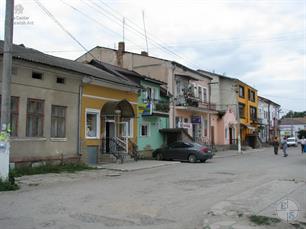 |
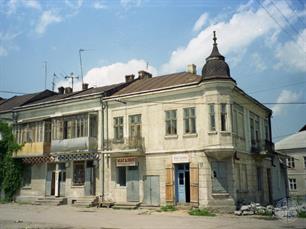 |
 |
| Jewish houses at the Market Square in Kopychyntsi, 2012 | Trace of mezuza on doors, 2018 | |
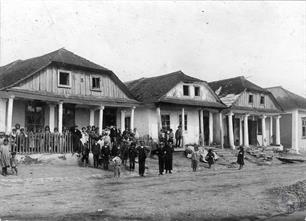 |
||
| Jews in Kopychyntsi, 1920s |
On May 1, 1943, the area of the ghetto was constricted and Jewish remnants from the area were brought in, among them Jews from Buczacz. A new action took place on June 3. Jews, mainly the recent additions, were taken to the forest next to the graveyard, were forced to dig their own graves and were shot. In fact, the executions lasted incessantly on June 3, 4, 7, 10 and 11, 1943. A total of 4,000 people were exterminated on those days. Only 1,000 people were still left at the ghetto.
On June 12 some 400 people were carried away from the ghetto in Kopyczynce to the ghetto in Chortkov, where they were killed. On June 18, 1943, 400 Jews were left at the Kopyczynce ghetto and the rest were taken to labor in neighboring estates.
On July 20, 1943, the final destruction of the ghetto and of the Jews scattered in the area, began. On that day the ghetto was surrounded, as were all houses inside it. Each house, each corner were throughly inspected to reveal the last of the hiders. The hiding places were discovered and people were shot on the spot. The lack of food and water forced them out and they fell in the hands of the enemy.
And yet, more than a few Jews managed to escape to the “Aryan” side of town. Although the local population handed over most of them to the Germans, there were still a number of Christian families who concealed their Jewish acquaintances at the risk of their own lives. Up until the conquest of the town by the Soviet Army on March 23, 1944, the survivors of the Jewish community were chased. 20 survivors gathered in town at the time of the liberation. The survivors left Kopyczynce before long to Poland and from there to Israel and other countries.
On June 12 some 400 people were carried away from the ghetto in Kopyczynce to the ghetto in Chortkov, where they were killed. On June 18, 1943, 400 Jews were left at the Kopyczynce ghetto and the rest were taken to labor in neighboring estates.
On July 20, 1943, the final destruction of the ghetto and of the Jews scattered in the area, began. On that day the ghetto was surrounded, as were all houses inside it. Each house, each corner were throughly inspected to reveal the last of the hiders. The hiding places were discovered and people were shot on the spot. The lack of food and water forced them out and they fell in the hands of the enemy.
And yet, more than a few Jews managed to escape to the “Aryan” side of town. Although the local population handed over most of them to the Germans, there were still a number of Christian families who concealed their Jewish acquaintances at the risk of their own lives. Up until the conquest of the town by the Soviet Army on March 23, 1944, the survivors of the Jewish community were chased. 20 survivors gathered in town at the time of the liberation. The survivors left Kopyczynce before long to Poland and from there to Israel and other countries.
The first Jews of Kopyczynce (in the 18th and early 19th Centuries) engaged in liquor sale, tenancy and trade, and a few, in crafts. With the growth of the settlement, the number of craftsmen, small merchants and peddlers increased. On the establishment of the Chassidic court of Rabbi Abraham-Yehoshua Heschel in Kopyczynce in 1894, a significant number of Jews made a living from services to the Chassidim who came to stay with their rabbi on Sabbath and Jewish holidays (innkeepers, restaurants, synagogue attendants, etc.). At that time, the craftsmen founded their union, Yad Harutzim, and the merchants' union was also established before WWI. There were no changes in the occupations of Jews in Kopyczynce during the inter-war period. The breakdown by occupation of loan receivers from Kupat Gmilut Hassadim (the benefactory fund established in 1927) for the years 1936-1937 is: 135 loans to craftsmen, 109 to small merchants, 30 to laborers, 5 to farmers and 20 to others. The Jewish Credit Union established under the auspices of the Joint, acted in Kopyczynce during the inter-war period; its members were the affluent merchants that dealt in wheat, wood, flax, etc.
During the 1930's the economic situation of the Jews of Kopyczynce worsened. Hardly recovered from the 1928-1931 crisis, they were faced with increasing competition from the Ukrainian and Polish cooperatives, and had to protect themselves, albeit with little success, from the schemes of the authorities and antisemitic actions both in town and in the nearby villages. In 1930, by a municipal edict, many Jewish market stalls were torn down with the claim that they were “not esthetic”. In the same year a Jewish merchant was forced under threats to close down his shop, located next to a Ukrainian cooperative. In 1936 there were aggressions against Jews of neighboring villages and peddlers selling to them, anti-Jewish pamphlets were circulated and windowpanes of Jewish homes were shattered. The slaughter edict of 1937 harmed cattle traders and many butchers; as a result, only 3 Jewish butcher shops were allowed.
During the 1930's the economic situation of the Jews of Kopyczynce worsened. Hardly recovered from the 1928-1931 crisis, they were faced with increasing competition from the Ukrainian and Polish cooperatives, and had to protect themselves, albeit with little success, from the schemes of the authorities and antisemitic actions both in town and in the nearby villages. In 1930, by a municipal edict, many Jewish market stalls were torn down with the claim that they were “not esthetic”. In the same year a Jewish merchant was forced under threats to close down his shop, located next to a Ukrainian cooperative. In 1936 there were aggressions against Jews of neighboring villages and peddlers selling to them, anti-Jewish pamphlets were circulated and windowpanes of Jewish homes were shattered. The slaughter edict of 1937 harmed cattle traders and many butchers; as a result, only 3 Jewish butcher shops were allowed.

- Home
- Shtetls
- Vinnytsia region
- Volyn region
- Dnipro region
- Donetsk region
- Zhytomyr region
- Zakarpattia region
- Zaporizhzhia region
- Ivano-Frankivsk region
- Kyiv region
- Kropyvnytskyi region
- Luhansk region
- Lviv region
- Mykolayiv region
- Odessa region
- Poltava region
- Rivne region
- Sumy region
- Ternopil region
- Kharkiv region
- Kherson region
- Khmelnytskyi region
- Chernihiv region
- Chernivtsi region
- Cherkasy region
- Crimea
- Synagogues
- Cemeteries
- Objects & guides
- Old photos
- History
- Contact
Jewish towns of Ukraine
My shtetl
My shtetl
Donate
Jewish towns of Ukraine
